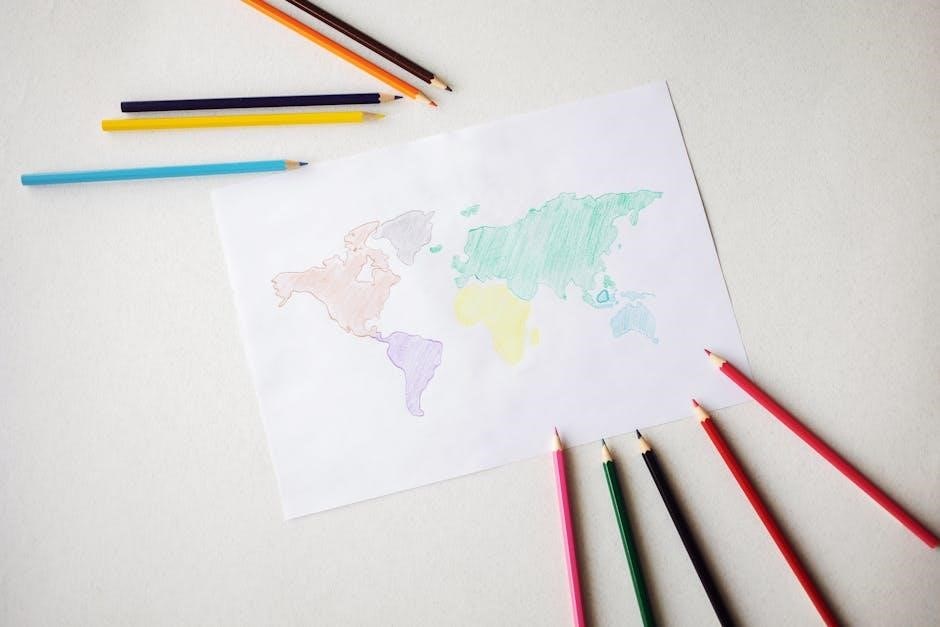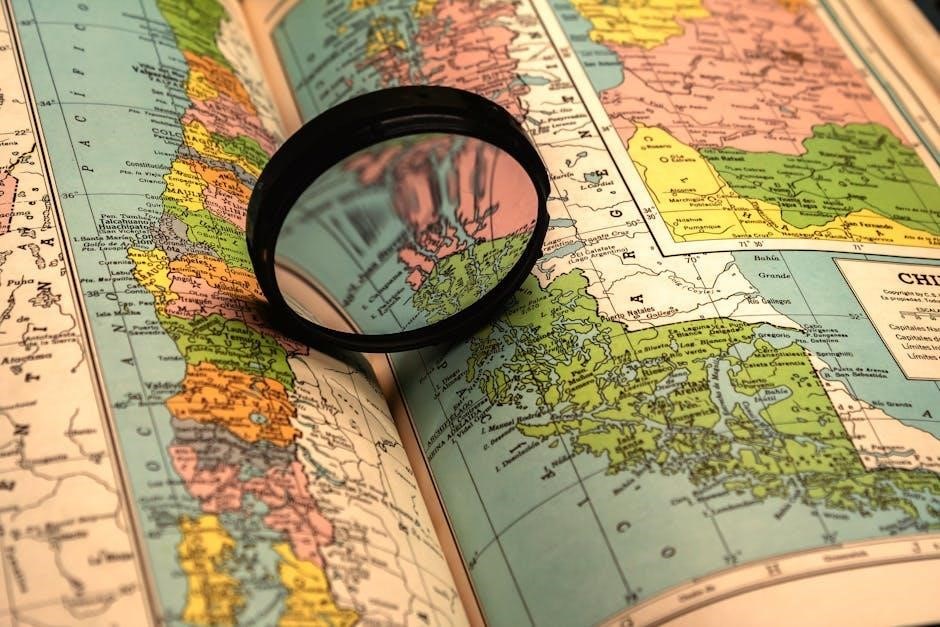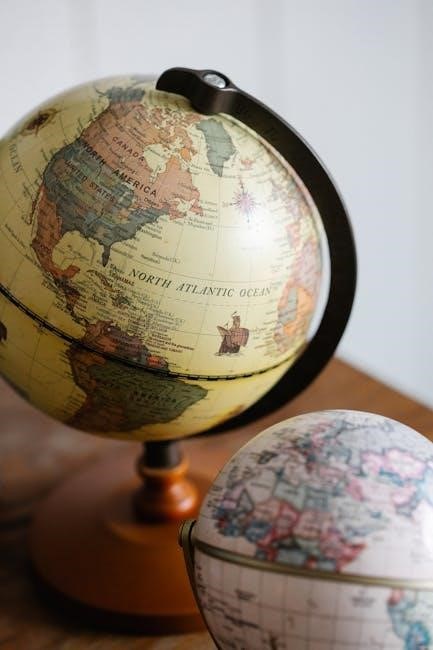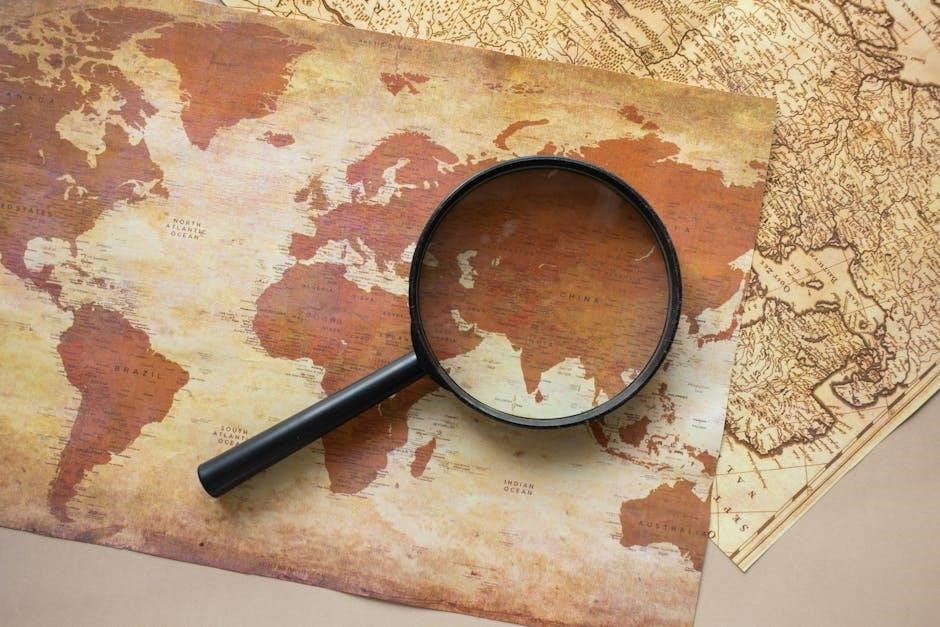This unit explores global conflicts from 1900 to the present, focusing on World Wars I and II, the Cold War, and modern warfare. It covers key themes, technologies, and societal impacts, preparing students for comprehensive understanding and exam success.
1.1 Overview of the Time Period (1900-Present)
This period spans two world wars, the Cold War, and modern conflicts, marking significant shifts in global power and technological advancements. The 20th century saw the rise and fall of empires, while the 21st century faces new challenges like terrorism and asymmetric warfare. Key themes include the introduction of devastating military technologies and the profound impact of war on societies worldwide.
- 1900-1945: Dominated by World Wars I and II, reshaping global politics and economies.
- 1945-1991: The Cold War defined international relations, with proxy wars and nuclear threats.
- 1991-Present: A new era of globalization, terrorism, and modern warfare technologies.
1.2 Key Themes: Conflict, Power Shifts, and Global Impact
This unit examines the transformative conflicts of the 20th and 21st centuries, emphasizing how warfare reshaped global power structures and societal dynamics. Key themes include the devastating consequences of total war, the rise and fall of empires, and the emergence of new superpowers. The period also highlights the global spread of ideologies, technological advancements, and the profound economic and social impacts of prolonged conflict.
- Conflict: Wars drove unprecedented human and material losses.
- Power Shifts: The rise of the U.S. and USSR, and later, multipolar systems.
- Global Impact: Economic crises, political instability, and societal transformations.

Causes of World War I
World War I arose from nationalism, imperialism, militarism, and the complex system of alliances. The assassination of Archduke Franz Ferdinand triggered the conflict, escalating tensions globally.
- Nationalism fueled rivalries among European nations.
- Imperialism led to colonial competition and resource disputes.
- Militarism increased military buildup and readiness for war.
- Alliances created a system of entangling obligations.
2.1 Nationalism and Imperialism
Nationalism and imperialism were key factors leading to World War I. Nationalism created intense rivalries among European nations, while imperialism fueled competition for colonies and resources. European powers sought to expand their empires, leading to territorial disputes and heightened tensions. This ideological clash set the stage for conflict, as nations prioritized their interests over diplomacy, ultimately contributing to the war’s outbreak.
- Nationalism intensified patriotic fervor and rivalry.
- Imperialism drove competition for colonies and resources.
- Both ideologies heightened global tensions and conflict.
2.2 Militarism and the Complex System of Alliances
Militarism and alliances exacerbated tensions before World War I. European nations engaged in arms races, glorifying military strength; The complex system of alliances, including the Triple Entente and Triple Alliance, created a volatile environment where localized conflicts could escalate into broader wars. These alliances and military buildups heightened suspicions, making diplomacy challenging and increasing the likelihood of global conflict.
- Militarism fueled arms races and aggressive posturing.
- Alliances created a web of mutual obligations.
- Together, they heightened tensions and made war more likely.
2.3 The Assassination of Archduke Franz Ferdinand
The assassination of Archduke Franz Ferdinand of Austria-Hungary in Sarajevo on June 28, 1914, was the immediate trigger for World War I. Gavrilo Princip, a Serbian nationalist, carried out the attack. This event sparked a chain reaction of alliances, leading Austria-Hungary to declare war on Serbia, which escalates into a global conflict. The assassination symbolized the volatile mix of nationalism and imperial tensions in Europe.
- Franz Ferdinand’s death was a direct cause of the war.
- The act was carried out by the Black Hand group.
- It led to Austria-Hungary’s ultimatum and the broader conflict.

Key Military Technologies of World War I
World War I introduced groundbreaking military technologies, including poison gas, machine guns, tanks, and aerial warfare, which transformed combat tactics and significantly increased casualties.
The introduction of poison gas and machine guns in World War I revolutionized combat, causing unprecedented casualties. Poison gas inflicted severe injuries, while machine guns enabled rapid, deadly firepower. These technologies transformed trench warfare, emphasizing the brutal efficiency of modern weaponry and shifting military tactics forever.
3.2 Development of Air Force and Naval Warfare
The development of air forces and naval warfare transformed military strategies during World War I. Airplanes were initially used for reconnaissance but soon evolved into bombers. Naval advancements included submarines and battleships, which played crucial roles in blockades and sea battles. The introduction of aircraft carriers marked the beginning of a new era in warfare, combining air and naval capabilities for enhanced combat effectiveness.
3.3 Trench Warfare and Its Impact on Casualties
Trench warfare during World War I led to massive casualties due to prolonged exposure to harsh conditions. Soldiers faced constant artillery bombardments, machine gun fire, and poison gas. The stalemate of trench warfare resulted in high death tolls, with millions killed or wounded. Additionally, diseases like trench foot and influenza spread rapidly in unsanitary conditions, further increasing the human cost of the war.

The Home Front and Total War
The home front during World War I saw widespread civilian mobilization, economic restructuring, and propaganda campaigns. Total war demanded unprecedented societal involvement, impacting daily life profoundly.
4.1 Mobilization of Civilians and Economies
During World War I, civilians were mobilized en masse to support the war effort. Governments redirected economies to produce weapons and supplies, while citizens engaged in labor and rationing. Propaganda fueled national unity, and women entered the workforce in unprecedented numbers. This total war approach required societies to adapt, blending military and civilian contributions to sustain the conflict effectively.
4.2 Propaganda and Nationalism in Wartime
Propaganda played a crucial role in mobilizing public support for war efforts. Governments used posters, media, and public figures to promote patriotism and demonize enemies. Nationalism was exploited to unify populations, fostering a sense of shared purpose. This manipulation of public sentiment helped sustain morale and justify sacrifices, while also fueling hatred and divisions that lingered long after conflicts ended.
4.3 The Role of Women in the War Effort
During wartime, women played pivotal roles in sustaining the war effort. They entered the workforce in unprecedented numbers, taking on roles in factories, agriculture, and military auxiliaries. Their contributions significantly supported the economies and military operations of nations. This shift challenged traditional gender roles, leading to lasting changes in societal perceptions and advancing women’s rights, including suffrage.

The Interwar Period and Rise of World War II
The interwar period (1918–1939) saw instability, economic crisis, and the rise of fascist regimes, ultimately leading to the outbreak of World War II in 1939.
5.1 The Treaty of Versailles and Its Consequences
The Treaty of Versailles (1919) ended World War I but imposed harsh terms on Germany, including heavy reparations, territorial losses, and the “war guilt clause.” This led to widespread resentment and economic hardship in Germany, fostering political instability. The treaty’s failure to establish a lasting peace contributed to the rise of fascist regimes, particularly in Germany, and set the stage for World War II.
5.2 The Great Depression and Political Instability
The Great Depression (1929-1939) caused global economic collapse, mass unemployment, and widespread poverty. This crisis eroded public trust in democratic systems, fostering political instability and the rise of extremist ideologies. In countries like Germany, Italy, and Japan, economic hardship fueled nationalist sentiments, enabling authoritarian leaders to seize power and pursue aggressive expansionist policies, ultimately contributing to World War II.
5.3 The Rise of Fascist and Nationalist Ideologies
The interwar period saw the rise of fascist and nationalist ideologies, fueled by economic crisis and political instability. Leaders like Hitler, Mussolini, and Tojo exploited nationalist sentiments, promising restoration of national pride and power. These regimes emphasized authoritarian control, militarism, and racial superiority, laying the groundwork for aggressive expansion and the outbreak of World War II.

Causes and Conduct of World War II
World War II arose from Axis aggression, with Germany, Italy, and Japan pursuing expansionist policies. The war involved global conflict, multiple fronts, and massive devastation.
6.1 Aggression by Axis Powers (Germany, Italy, Japan)
Germany, under Hitler, pursued aggressive expansion, invading Poland in 1939, while Italy, led by Mussolini, sought dominance in the Mediterranean. Japan, aiming to expand its empire, attacked China and Southeast Asia. These actions, driven by nationalist ambitions, led to the formation of the Axis alliance and the outbreak of World War II, reshaping global power dynamics.
6.2 The Holocaust and Genocide
The Holocaust, orchestrated by Nazi Germany, systematically exterminated six million Jews and millions of others deemed undesirable. Genocide during World War II targeted specific ethnic, political, and social groups, showcasing extreme human rights violations. These atrocities remain a stark reminder of the dangers of unchecked hatred and totalitarian regimes, deeply impacting global consciousness and historical memory.
6.3 The Role of Technology in Modern Warfare
World War II saw significant advancements in military technology, including the development of atomic bombs, jet aircraft, and guided missiles. These innovations transformed warfare tactics and strategies, increasing destruction capabilities and setting the stage for the Cold War. The introduction of radar, encryption, and amphibious assault vehicles also played crucial roles, showcasing how technology became a decisive factor in modern conflict.

The Cold War and Its Global Impact
The Cold War was a period of tension between major world powers, marked by an arms race, nuclear threats, and proxy wars. It shaped global alliances and conflicts, creating long-lasting political and economic divides, notably the Iron Curtain, influencing international relations and modern geopolitical dynamics.
7.1 The Division of Europe and the Iron Curtain
After World War II, Europe was divided into Eastern and Western blocs, separated by the Iron Curtain. The Yalta Conference solidified this division, with the Soviet Union dominating the East and the United States influencing the West. This ideological and physical divide led to heightened tensions, shaping the Cold War landscape and defining international relations for decades, symbolizing the deepening rift between communism and capitalism.
7.2 The Arms Race and Nuclear Warfare
The Cold War era saw an intense arms race between the United States and the Soviet Union, driven by the development of nuclear weapons. This competition escalated tensions, with both superpowers stockpiling arsenals to ensure mutual deterrence. The introduction of intercontinental ballistic missiles and the doctrine of mutually assured destruction (MAD) highlighted the catastrophic potential of nuclear warfare, reshaping global security and diplomacy.
7.3 Proxy Wars and Decolonization
During the Cold War, proxy wars became a means for superpowers to exert influence without direct conflict. Meanwhile, decolonization reshaped the global map as colonies sought independence. The U.S. and Soviet Union often supported opposing sides in these struggles, while newly independent nations navigated geopolitical pressures, aligning with either bloc or pursuing non-alignment, further complicating the international landscape.
Globalization and Modern Conflict
Globalization has reshaped modern conflict, emphasizing international cooperation and economic ties. It has also fueled terrorism and asymmetric warfare, highlighting the complex balance between unity and conflict in an interconnected world.
8.1 The Role of International Organizations (UN, NATO)
International organizations like the United Nations (UN) and NATO play crucial roles in maintaining global peace and security. The UN, established after WWII, focuses on diplomacy, conflict resolution, and humanitarian aid, while NATO provides collective defense against threats. These organizations foster cooperation, preventing conflicts and addressing global challenges, thus shaping modern international relations and reducing the likelihood of widespread warfare. Their influence is vital in today’s interconnected world.
8.2 Asymmetric Warfare and Terrorism
Asymmetric warfare involves conflicts where non-state actors or weaker forces use unconventional tactics against stronger opponents. Terrorism, a key component, targets civilians to instill fear and disrupt societies. Modern asymmetric warfare often employs guerrilla tactics, cyberattacks, and drone strikes. These strategies challenge traditional military superiority, making them difficult to counter and creating global security challenges that require innovative responses and international cooperation to address effectively.
8.3 The Impact of Economic Globalization on Warfare
Economic globalization has reshaped modern warfare by creating interdependent economies and new vulnerabilities. Global supply chains and trade networks can be disrupted, impacting military resources. Additionally, economic sanctions and cyberattacks on financial systems have become strategic tools. This interconnectivity blurs the lines between traditional warfare and economic conflict, making global cooperation essential to mitigate risks and ensure stability in an increasingly interconnected world.
This unit concludes with a summary of global warfare’s key events, themes, and impacts. Reviewing strategies and concepts ensures preparedness for assessments and reinforces understanding of modern conflict dynamics.
9.1 Summary of Key Events and Themes
Unit 7 covers global warfare from 1900 to the present, highlighting World Wars I and II, the Cold War, and modern conflicts. Key themes include nationalism, imperialism, and technological advancements. The unit explores the shift in global power dynamics, the rise of fascist ideologies, and the impact of total war on societies. Understanding these events and themes is crucial for grasping the complexities of modern international relations and conflict.
9.2 Preparing for the Exam: Key Concepts and Strategies
Focus on understanding the causes and consequences of global conflicts, such as World Wars I and II, and the Cold War. Key concepts include nationalism, imperialism, and technological advancements. Use active recall and practice essays to reinforce knowledge. Review timelines, key leaders, and economic impacts. Utilize concept maps and flashcards for retention. Prioritize understanding themes over memorizing dates, and practice analyzing primary sources for exam success.



